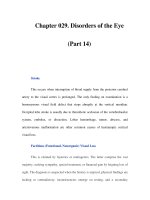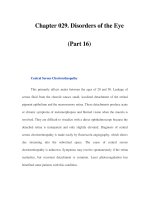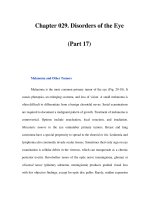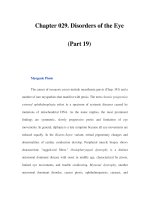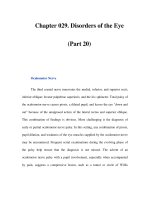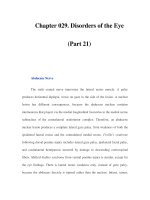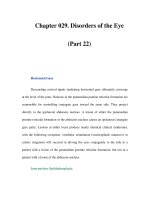Chapter 029. Disorders of the Eye (Part 21) pps
Bạn đang xem bản rút gọn của tài liệu. Xem và tải ngay bản đầy đủ của tài liệu tại đây (14.65 KB, 5 trang )
Chapter 029. Disorders of the Eye
(Part 21)
Abducens Nerve
The sixth cranial nerve innervates the lateral rectus muscle. A palsy
produces horizontal diplopia, worse on gaze to the side of the lesion. A nuclear
lesion has different consequences, because the abducens nucleus contains
interneurons that project via the medial longitudinal fasciculus to the medial rectus
subnucleus of the contralateral oculomotor complex. Therefore, an abducens
nuclear lesion produces a complete lateral gaze palsy, from weakness of both the
ipsilateral lateral rectus and the contralateral medial rectus. Foville's syndrome
following dorsal pontine injury includes lateral gaze palsy, ipsilateral facial palsy,
and contralateral hemiparesis incurred by damage to descending corticospinal
fibers. Millard-Gubler syndrome from ventral pontine injury is similar, except for
the eye findings. There is lateral rectus weakness only, instead of gaze palsy,
because the abducens fascicle is injured rather than the nucleus. Infarct, tumor,
hemorrhage, vascular malformation, and multiple sclerosis are the most common
etiologies of brainstem abducens palsy.
After leaving the ventral pons, the abducens nerve runs forward along the
clivus to pierce the dura at the petrous apex, where it enters the cavernous sinus.
Along its subarachnoid course it is susceptible to meningitis, tumor (meningioma,
chordoma, carcinomatous meningitis), subarachnoid hemorrhage, trauma, and
compression by aneurysm or dolichoectatic vessels. At the petrous apex,
mastoiditis can produce deafness, pain, and ipsilateral abducens palsy
(Gradenigo's syndrome). In the cavernous sinus, the nerve can be affected by
carotid aneurysm, carotid cavernous fistula, tumor (pituitary adenoma,
meningioma, nasopharyngeal carcinoma), herpes infection, and Tolosa-Hunt
syndrome.
Unilateral or bilateral abducens palsy is a classic sign of raised intracranial
pressure. The diagnosis can be confirmed if papilledema is observed on fundus
examination. The mechanism is still debated but is probably related to rostral-
caudal displacement of the brainstem. The same phenomenon accounts for
abducens palsy from low intracranial pressure (e.g., after lumbar puncture, spinal
anesthesia, or spontaneous dural cerebrospinal fluid leak).
Treatment of abducens palsy is aimed at prompt correction of the
underlying cause. However, the cause remains obscure in many instances, despite
diligent evaluation. As mentioned above for isolated trochlear or oculomotor
palsy, most cases are assumed to represent microvascular infarcts because they
often occur in the setting of diabetes or other vascular risk factors. Some cases
may develop as a postinfectious mononeuritis (e.g., following a viral flu). Patching
one eye or applying a temporary prism will provide relief of diplopia until the
palsy resolves. If recovery is incomplete, eye muscle surgery can nearly always
realign the eyes, at least in primary position. A patient with an abducens palsy that
fails to improve should be reevaluated for an occult etiology (e.g., chordoma,
carcinomatous meningitis, carotid cavernous fistula, myasthenia gravis).
Multiple Ocular Motor Nerve Palsies
These should not be attributed to spontaneous microvascular events
affecting more than one cranial nerve at a time. This remarkable coincidence does
occur, especially in diabetic patients, but the diagnosis is made only in retrospect
after exhausting all other diagnostic alternatives. Neuroimaging should focus on
the cavernous sinus, superior orbital fissure, and orbital apex, where all three
ocular motor nerves are in close proximity. In the diabetic or compromised host,
fungal infection (Aspergillus, Mucorales, Cryptococcus) is a frequent cause of
multiple nerve palsies. In the patient with systemic malignancy, carcinomatous
meningitis is a likely diagnosis. Cytologic examination may be negative despite
repeated sampling of the cerebrospinal fluid. The cancer-associated Lambert-
Eaton myasthenic syndrome can also produce ophthalmoplegia. Giant cell
(temporal) arteritis occasionally manifests as diplopia from ischemic palsies of
extraocular muscles. Fisher syndrome, an ocular variant of Guillain-Barré,
produces ophthalmoplegia with areflexia and ataxia. Often the ataxia is mild, and
the reflexes are normal. Antiganglioside antibodies (GQ1b) can be detected in
about 50% of cases.
Supranuclear Disorders of Gaze
These are often mistaken for multiple ocular motor nerve palsies. For
example, Wernicke's encephalopathy can produce nystagmus and a partial deficit
of horizontal and vertical gaze that mimics a combined abducens and oculomotor
nerve palsy. The disorder occurs in malnourished or alcoholic patients and can be
reversed by thiamine. Infarct, hemorrhage, tumor, multiple sclerosis, encephalitis,
vasculitis, and Whipple's disease are other important causes of supranuclear gaze
palsy. Disorders of vertical gaze, especially downwards saccades, are an early
feature of progressive supranuclear palsy. Smooth pursuit is affected later in the
course of the disease. Parkinson's disease, Huntington's chorea, and
olivopontocerebellar degeneration can also affect vertical gaze.
The frontal eye field of the cerebral cortex is involved in generation of
saccades to the contralateral side. After hemispheric stroke, the eyes usually
deviate towards the lesioned side because of the unopposed action of the frontal
eye field in the normal hemisphere. With time, this deficit resolves. Seizures
generally have the opposite effect: the eyes deviate conjugately away from the
irritative focus. Parietal lesions disrupt smooth pursuit of targets moving toward
the side of the lesion. Bilateral parietal lesions produce Balint's syndrome,
characterized by impaired eye-hand coordination (optic ataxia), difficulty
initiating voluntary eye movements (ocular apraxia), and visuospatial
disorientation (simultanagnosia).

